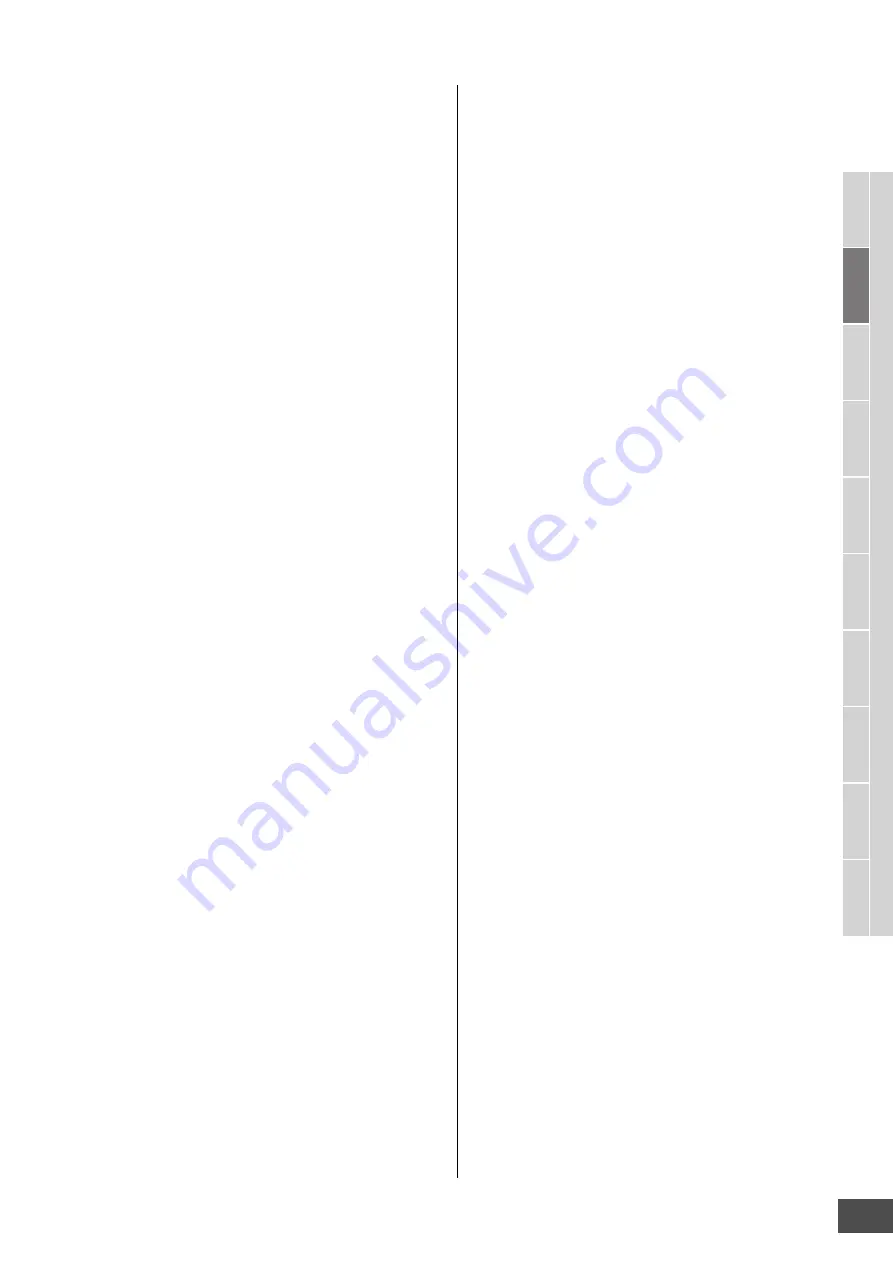
Editing a Performance
MOTIF XF Reference Manual
113
V
oice mode
Song mode
P
a
tt
er
n mode
Mixing mode
Mast
er mode
Utility mode
F
ile mode
P
erf
or
mance
mode
Sampling
mode 1
Sampling
mode 2
R
e
fe
rence
currently assigned Voice is maintained. The name of the
Voice registered to the Arpeggio Type is shown at the right
side.
Settings:
off (not copied), on (copied)
n
A User Voice may be registered to a certain Arpeggio Type via
the Voice with ARP function. With the factory settings, each of
the combinations of an Arpeggio Type and its companion User
Voice is designed to be the most suitable match and produce
the appropriate sound/phrase. However, when revising the
sound of the User Voice by editing the parameters or storing a
different Voice to the corresponding User Voice number, this
combination may become improper or produce an
unexpected sound. If such a situation occurs, select the most
appropriate Voice for the current Arpeggio Type on the [F1]
Voice display.
7
Tempo*
Determines the Arpeggio Tempo.
Settings:
5.0 – 300.0
n
If you are using this instrument with an external sequencer,
MIDI computer, or other MIDI device, and you want to
synchronize it with that device, set the MIDI sync (
5
)
parameter in the MIDI display (page 228) of the Utility mode to
“MIDI” or “auto.” In this case, the Tempo parameter here
indicates “MIDI” or “auto” and cannot be changed.
8
Key Mode
Determines how the Arpeggio plays back when playing the
keyboard.
Settings:
sort, thru, direct, sort+direct, thru+direct
sort
When you play specific notes (for example, the notes of a chord), the
same sequence plays, no matter what order you play the notes.
thru
When you play specific notes (for example, the notes of a chord), the
resulting sequence differs depending on the order of the notes.
direct
Note events of the Arpeggio sequence do not play; only the notes you
play on the keyboard are heard. When the Arpeggio plays back, the
events such as Pan and Brightness are applied to the sound of your
keyboard performance. Use this setting when the Arpeggio types
includes non-note data or when the Category type “Ctrl” is selected.
sort+direct
The Arpeggio is played back according to the “sort” setting here, and
the note pressed is also sounded.
thru+direct
The Arpeggio is played back according to the “thru” setting here, and
the note pressed is also sounded.
n
Some Arpeggio types belonging to the “Cntr” Category may
not have note events (page 18). When such an Arpeggio type
is selected and the Key Mode is set to “sort” or “thru,” no
sound is produced even if you press a note on the keyboard.
9
Velocity Mode
Adjusts the velocity of the Arpeggio notes.
Settings:
original, thru
original
The Arpeggio plays back at the preset velocities included in the
Arpeggio sequence data.
thru
The Arpeggio plays back according to the velocity of your playing. For
example, if you play the notes strongly, the playback volume of the
Arpeggio increases.
)
Output Octave Shift
Specifies the maximum Arpeggio range in octaves.
Settings:
-10 – +10
!
[SF1] ARP1 – [SF5] ARP5 (Arpeggio 1 – 5)
buttons
The six parameters Bank (
@
) through Gate Time Rate (
&
)
at the lower half Part of the display, can be edited in each
of the [SF1] ARP1 through [SF5] ARP5 displays. You can
set the parameters in the lower half of the display for each
of the five Arpeggio settings by pressing one of the [SF1] –
[SF5] buttons. The 8th note icon shown in the tab menu
indicates any Arpeggio Type (other than “off”) is selected in
the display corresponding to the Sub Function button.
Settings:
[SF1] – [SF5] (Sub Function) buttons
@
Bank*
Determines the Arpeggio Bank containing the desired
Arpeggio type. Select “PRE” if you wish to select a preset
Arpeggio Type. Select “USR” if you wish to select an
Arpeggio Type you originally created and stored.
Settings:
PRE, USR
n
For detailed instructions on creating your original Arpeggio
type, see page 20.
#
Category*
$
Sub Category*
Determines the Arpeggio Category and Sub Category
including the desired Arpeggio type. These parameters are
available when “PRE” is selected as the Bank.
Settings:
Refer to the Arpeggio Category List on page 15.
n
You can call up the list by pressing the [SF6] LIST button then
select the desired item from the list.
n
For details about how to use the Arpeggio Type List in the Data
List, see page 16.
%
Type*
Determines the desired Arpeggio Type number from the
specified Category. The name of the selected Arpeggio
Type is shown at right of the specified number on the
display. Refer to the Arpeggio Type List in Data List.
^
Velocity Rate
Determines the offset value by which the Arpeggio notes
will be shifted from their original velocities. If the resultant
velocity value is less than zero it will be set to 1, and if the
resultant velocity is greater than 128 it will be set to 127.
This parameter can be changed via the Knob directly.
Settings:
-100% – +0% – +100%
&
Gate Time Rate
Determines the Gate Time (length) of the Arpeggio notes.
The Gate Time cannot be decreased beyond its normal
minimum of 1; any values outside that range will
automatically be limited to the minimum.
This parameter can be changed via the Knob directly.
Settings:
-100% – +0% – +100%
































